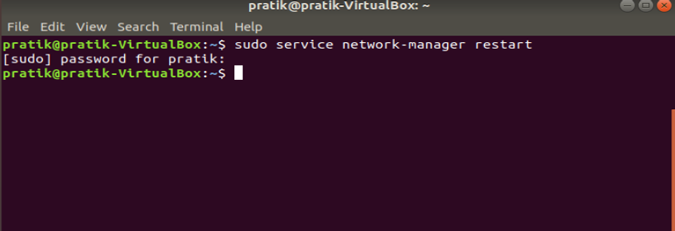Sudo Service Sshd Restart Program
Overview
Issue: The service is already running after Ansible stopped it, which looks like sshd was never stopped in the first place. Command used to check the status: service ssh status. I used this command with state:stopped also but the sshd is still running. I have been facing this issue for so long. I tried with state:restarted also. Sudo service sshd restart; 13. After the instance has restarted, connect to it with any SSH client and add the AWS Delegated Administrators group to the sudoers list by performing the following steps: Open the sudoers file with the following command: sudo visudo; Add. Sudo service sshd restart. Restart SSH For OpenBSD /etc/rc.d/sshd restart. Doas /etc/rc.d/sshd restart. Share on facebook. Share on twitter. Share on linkedin. Share on telegram. Share on whatsapp. Add Extra IP addresses to server configuration On Ubuntu 17.10 and later.
PowerShell remoting normally uses WinRM for connection negotiation and data transport. SSH is nowavailable for Linux and Windows platforms and allows true multiplatform PowerShell remoting.
Sudo Systemctl Restart Sshd.service
WinRM provides a robust hosting model for PowerShell remote sessions. SSH-based remoting doesn'tcurrently support remote endpoint configuration and Just Enough Administration (JEA).
SSH remoting lets you do basic PowerShell session remoting between Windows and Linux computers. SSHremoting creates a PowerShell host process on the target computer as an SSH subsystem. Eventuallywe'll implement a general hosting model, similar to WinRM, to support endpoint configuration andJEA.
The New-PSSession, Enter-PSSession, and Invoke-Command cmdlets now have a new parameter set tosupport this new remoting connection.
To create a remote session, you specify the target computer with the HostName parameter andprovide the user name with UserName. When running the cmdlets interactively, you're prompted fora password. You can also use SSH key authentication using a private key file with theKeyFilePath parameter. Creating keys for SSH authentication varies by platform.
General setup information
PowerShell 6 or higher, and SSH must be installed on all computers. Install both the SSH client(ssh.exe) and server (sshd.exe) so that you can remote to and from the computers. OpenSSH forWindows is now available in Windows 10 build 1809 and Windows Server 2019. For more information, seeManage Windows with OpenSSH. For Linux,install SSH, including sshd server, that's appropriate for your platform. You also need to installPowerShell from GitHub to get the SSH remoting feature. The SSH server must be configured to createan SSH subsystem to host a PowerShell process on the remote computer. And, you must enablepassword or key-based authentication.
Set up on a Windows computer
Install the latest version of PowerShell. For more information, seeInstalling PowerShell Core on Windows.
You can confirm that PowerShell has SSH remoting support by listing the
New-PSSessionparametersets. You'll notice there are parameter set names that begin with SSH. Those parameter setsinclude SSH parameters.Install the latest Win32 OpenSSH. For installation instructions, seeGetting started with OpenSSH.
Note
If you want to set PowerShell as the default shell for OpenSSH, seeConfiguring Windows for OpenSSH.
Edit the
sshd_configfile located at$env:ProgramDatassh.Make sure password authentication is enabled:
Coffee shopgamerate. Create the SSH subsystem that hosts a PowerShell process on the remote computer:
Note
The default location of the PowerShell executable is
c:/progra~1/powershell/7/pwsh.exe. Thelocation can vary depending on how you installed PowerShell.You must use the 8.3 short name for any file paths that contain spaces. There's a bug inOpenSSH for Windows that prevents spaces from working in subsystem executable paths. For moreinformation, see this GitHub issue.
The 8.3 short name for the
Program Filesfolder in Windows is usuallyProgra~1. However,you can use the following command to make sure:Optionally, enable key authentication:
For more information, see Managing OpenSSH Keys.
Restart the sshd service.
Add the path where OpenSSH is installed to your Path environment variable. For example,
C:Program FilesOpenSSH. This entry allows for thessh.exeto be found.
Set up on an Ubuntu 16.04 Linux computer
Install the latest version of PowerShell, seeInstalling PowerShell Core on Linux.
Install Ubuntu OpenSSH Server.
Edit the
sshd_configfile at location/etc/ssh.Make sure password authentication is enabled:
Optionally, enable key authentication:
For more information about creating SSH keys on Ubuntu, see the manpage forssh-keygen.
Add a PowerShell subsystem entry:
Note
The default location of the PowerShell executable is
/usr/bin/pwsh. The location can varydepending on how you installed PowerShell.Optionally, enable key authentication:
Restart the ssh service.
Set up on a macOS computer
Install the latest version of PowerShell. For more information,Installing PowerShell Core on macOS.
Make sure SSH Remoting is enabled by following these steps:
- Open
System Preferences. - Click on
Sharing. - Check
Remote Loginto setRemote Login: On. - Allow access to the appropriate users.
- Open
Edit the
sshd_configfile at location/private/etc/ssh/sshd_config.Use a text editor such as nano:
Make sure password authentication is enabled:
Add a PowerShell subsystem entry:
Note
The default location of the PowerShell executable is
/usr/local/bin/pwsh. The location canvary depending on how you installed PowerShell.Optionally, enable key authentication:
Restart the sshd service.
Authentication
PowerShell remoting over SSH relies on the authentication exchange between the SSH client and SSHservice and doesn't implement any authentication schemes itself. The result is that any configuredauthentication schemes including multi-factor authentication are handled by SSH and independent ofPowerShell. For example, you can configure the SSH service to require public key authentication anda one-time password for added security. Configuration of multi-factor authentication is outside thescope of this documentation. Refer to documentation for SSH on how to correctly configuremulti-factor authentication and validate it works outside of PowerShell before attempting to use itwith PowerShell remoting.

Note

Users retain the same privileges in remote sessions. Meaning, Administrators have access to anelevated shell, and normal users will not.
PowerShell remoting example
The easiest way to test remoting is to try it on a single computer. In this example, we create aremote session back to the same Linux computer. We're using PowerShell cmdlets interactively so wesee prompts from SSH asking to verify the host computer and prompting for a password. You can do thesame thing on a Windows computer to ensure remoting is working. Then, remote between computers bychanging the host name.

Limitations
The sudo command doesn't work in a remote session to a Linux computer.
PSRemoting over SSH does not support Profiles and does not have access to
$PROFILE. Once in asession, you can load a profile by dot sourcing the profile with the full filepath. This is notrelated to SSH profiles. You can configure the SSH server to use PowerShell as the default shelland to load a profile through SSH. See the SSH documentation for more information.Prior to PowerShell 7.1, remoting over SSH did not support second-hop remote sessions. Thiscapability was limited to sessions using WinRM. PowerShell 7.1 allows
Enter-PSSessionandEnter-PSHostProcessto work from within any interactive remote session.
See also
Why you need to Restart SSH Service
As root System Administrators its one of the common tasks you need to be done on live servers is restarting services.If you change ssh configuration file (for example you change the SSH port number) this modification require a restart to take effect.
How To Restart SSH Service under Linux / UNIX
For CentOS / RHEL / Fedora / Redhat Linux Restart SSH
Restart SSH On RHEL/CentOS/Fedora Linux with systemd
Restart SSH On Debian / Ubuntu Linux
Restart SSH On Debian/Ubuntu/Mint Linux with systemd
Restart SSH On For FreeBSD
Restart SSH For OpenBSD
Categories

- Apache (6)
- CloudLinux (2)
- cPanel (3)
- DirectAdmin (2)
- Domains (11)
- General Topics (22)
- Install SSL Certificate (12)
- Linux (40)
- Manage Emails (6)
- MS SQL Server (1)
- MySQL (6)
- PHP (3)
- Plesk Control Panel (16)
- SSL Certificates (23)
- Support (1)
- Technical Support (6)
- Web Security (2)
- WHM/cPanel (56)
- Windows Server (5)
- Windows Server IIS (1)
Tags
